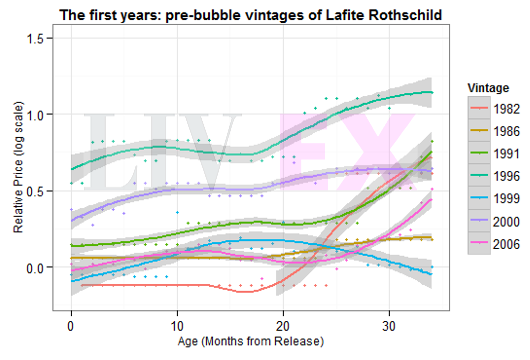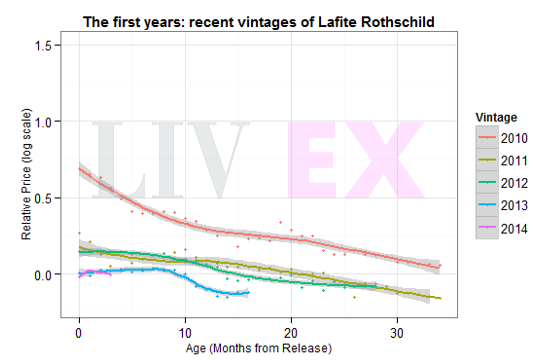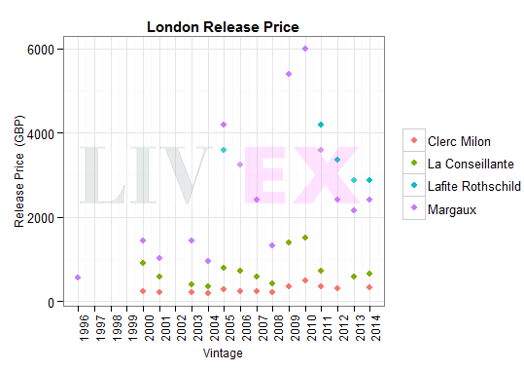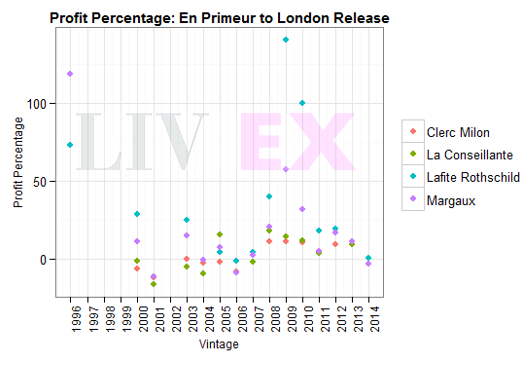Liv-ex has opened up the blog to Martin Klimmek (winequant.com). Martin is a ‘Data Scientist’ who moonlights in the wine world. He is known in the financial mathematics community for work on model-independent pricing and hedging (Bruti-Liberati Prize 2012). Here he uses Liv-ex data to look at the relationship between En Primeur pricing and the market cycle for Bordeaux fine wine.
Was there a bubble in fine wine market prices in 2009 and 2010? Prices have certainly dropped considerably across the board over the last four years. Like any other financial market, the fine wine market follows a pattern of boom and bust. The picture is complicated by the fact that fine wine is an asset with a bounded life-cycle. Only the most iconic vintages will hold their value over fifty years. There is another crucial difference. In the Bordeaux wine market, still the most important by volume, the most recent bubble was “sticky”.
The drop in the secondary market hasn't translated into investor opportunities because En Primeur prices for new blue-chip wines are stuck to 2009/2010 levels. Rather than developing in value from release, recent vintages have lost relative value. Investors are waiting for prices to adjust from an inflated release, while En Primeur buyers of blue-chips and early investors in the secondary market are licking their wounds after losing money on recent vintages.
Historically, with few exceptions (1999 being one), most wines would appreciate in value over the first years after En Primeur. We see this in the graph above. In contrast, recent vintages have all declined, see below.
The game has changed. Investors can no longer rely on blue-chip En Primeur investment to generate value. It is now a waiting game for the ‘third release’. Following En Primeur and release into the secondary market, the third release occurs when market prices reach levels where the risk of further downward correction is balanced by the promise of future reward. This is the level that wines should have been released at in the first place.
Two forces are now at play. Older vintages follow an established market cycle (the last peak-to-peak cycle took ten years). Meanwhile, new vintages must first adjust into the market from sticky-release prices. Need more evidence? Consider the ex-Château release prices for the bluest of blue-chips, Lafite Rothschild. Note how record release prices in 2005 and 2009/2010 were followed by slowly-decreasing prices in later years.
The En Primeur market for Lafite Rothschild is inefficient. Today's release price does not reflect today's secondary market demand. The swings in profit percentages made by the supply chain – those who buy at En Primeur and bring the wines to market – tell the story.
We find that across the board of blue-chip wines, Châteaux tend to sell too cheaply during the boom, leaving money on the table. They then set prices too high in the following years. In the language of behavioural economics: a boom sets new reference levels for release prices, producers regret not having set the bar higher. They are then sensitive to the issue. To minimise regret, new vintages are priced cautiously.
The fine wine market cycle is exacerbated by inefficient ex-Château pricing. By setting prices too low and then too high, producers fuel the fire before depressing the recovery. The result is a speculative pattern of irrational exuberance and regret, which is tearing the En Primeur-system apart.
Rather than fearing regret, producers would do well to poll the secondary market before En Primeur-campaigns. Better informational efficiency would benefit all sides, in good and in bad times. In the mean time, there are opportunities to look towards less powerful producers. Power and regret go hand in hand.









